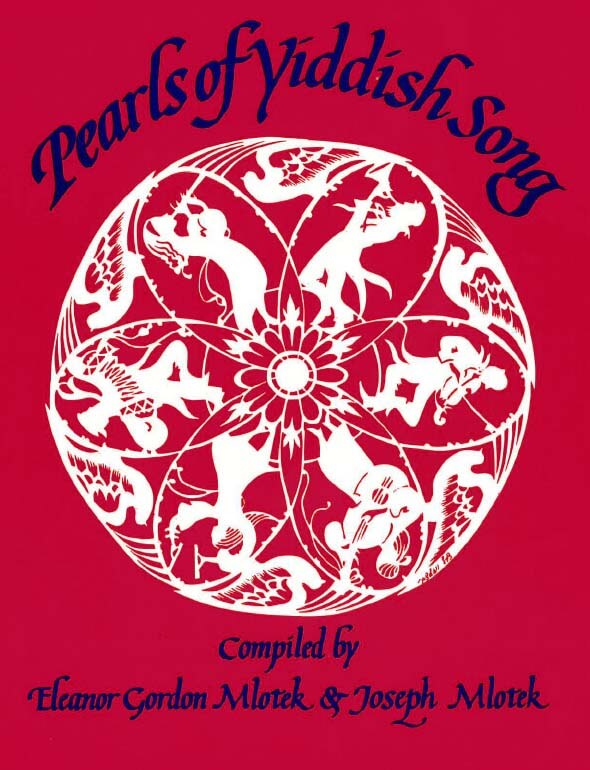Words by M. Sorerives, pen name of Khayim Miller (1869-1909); music by M. Posner (1890 – 1931). Published in sheet music (for four voices) by the United Hebrew Choral Societies of U.S. and Canada, Bronx, N.Y., 1923. The song remains a popular repertory number in the Workmen’s Circle choruses in the United States.

Whose voice do I hear ringing?
Let new songs be sung!
Everything evil has passed
along with the long, cold winter.
Rich in colors, rich in sounds
the First of May arrives.
Whose voice do I hear ringing?
Let freedom songs be sung!
Slavery is coming to an end.
The clanging lightens, the chains loosen,
brightly adorned with fresh flowers
the First of May arrives.
Whose voice do I hear ringing?
Let us sing cheerfully and loud!
that our song may carry boundlessly
from all corners.
Awakening us to a new life,
the First of May arrives.
Vemes shtime her ikh klingen?
Naye lider zol men zingen!
Al dos beyze iz farbay,
Mit dem vinter, kaltn, langn.
Raykh in farbn, raykh in klangen
Kumt tsu geyn der ershter may.
Vemes shtime her ikh klingen?
Fraye lider zol men zingen!
S’nemt a sof tsu shklaferay!
Loyz di klangen, loyz di keytn.
Hel baputst mit frishe kveytn
Tumt tsu geyn der ershter may.
Vemes shtime her ikh klingen?
Hoykh un munter zol men zingen!
Zol zikh trogn frank un fray
Undzer lid fun ale ekn.
Tsu a nayem lebn vekn,
Kumt tsu geyn der ershter may.
װעמעס שטימע הער איך קלינגען?
נײַע לידער זאָל מען זינגען!
אַל דאָס בײזע איז פֿאַרבײַ,
מיט דעם װינטער, קאַלטן, לאַנגן.
רײַך אין פֿאַרבן, רײַך אין קלאַנגען
קומט צו גײן דער ערשטער מײַ.
װעמעס שטימע הער איך קלינגען?
פֿרײַע לידער זאָל מען זינגען!
ס’נעמט אַ סוף צו שקלאַפֿערײַ!
לױז די קלאַנגען, לױז די קײטן.
העל באַפּוצט מיט פֿרישע קװײטן
קומט צו גײן דער ערשטער מײַ.
װעמעס שטימע הער איך קלינגען?
הױך און מונטער זאָל מען זינגען!
זאָל זיך טראָגן פֿראַנק און פֿרײַ
אונדזער ליד פֿון אַלע עקן.
צו אַ נײַעם לעבן װעקן,
קומט צו גײן דער ערשטער מײַ.
Song Title: May-lid

First published in 1988 as Pearls of Yiddish Song: Favorite Folk, Art and Theatre Songs, this anthology contains 115 songs. Some material had never been published, while others, included in rare song collections or sheet music, were largely inaccessible. The songs presented reflect Jewish life in Eastern Europe and the United States and depict childhood, love, family celebrations, poverty, work and struggle. There are also songs from the Hasidic and Maskilic movements, songs of Zion and of America, as well as songs from the Yiddish theater.
The title of this anthology derives from the weekly two-page feature column “Pearls of Yiddish Poetry,” which the compilers Yosl and Chana Mlotek initiated in 1970 in the Yiddish newspaper Der Forvertz (the Yiddish Daily Forward). Hundreds of readers from around the world — including authors, composers, singers, actors — became co-participants in this collective folk project and recalled melodies, lines, fragments, stanzas and their variants of songs, poems, and plays which they had heard in their youth. At first, readers sent in only written material. Later, they also taped songs on cassettes, many of whose melodies had, until then, never been recorded. They also identified and supplied missing information regarding lyricists, poets, and composers and described the circumstances surrounding the songs’ origins, their dissemination, diffusion and impact.